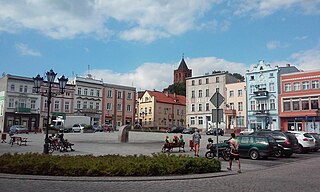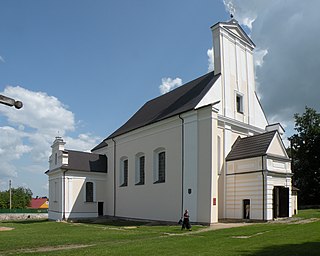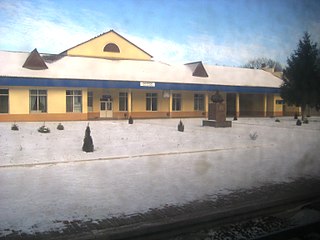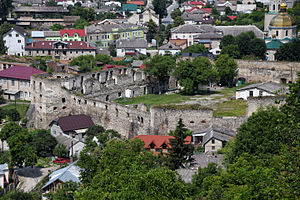
Michał Wiśniowiecki or Mykhailo Vyshnevetsky (1529–1584) was a Ruthenian noble (szlachcic) of Polish–Lithuanian Commonwealth. He was a prince at Wiśniowiec, magnate, Senior of Registered Cossacks, Hetman of Zaporozhian Cossacks, castellan of Bracław and Kijów, starost of Czerkasy, Kaniów, Lubeka and Łojów. Great-grandfather of the future King of Poland, Michał Korybut Wiśniowiecki.

Ovruch is a city in Korosten Raion, Zhytomyr Oblast, northern Ukraine. Prior to 2020, it was the administrative center of the former Ovruch Raion. It has a population of approximately 15,250, and is home to the Ovruch air base.

Szczyrzyc is a village in Poland, located in the Lesser Poland Voivodeship, Limanowa County, Jodłownik Commune.

Nowe is a town in Świecie County, Kuyavian-Pomeranian Voivodeship, Poland, with 6,270 inhabitants (2004). It is located within the ethnocultural region of Kociewie.

The Battle of Shepeleviche (Szepielewicze) or Battle of Ciecierzyn on 24 August 1654 was one of the first battles of the Russo-Polish War (1654–67). It ended with a Russian victory.

Bezdonys is a town in Lithuania, located to the north of Vilnius, within the Vilnius district municipality. It is best known for the 1908 Bezdany raid, one of the most daring and successful train robberies in history. According to the Lithuanian census of 2011, the town had 743 inhabitants.

Łapczyna Wola is a village in the administrative district of Gmina Kluczewsko, within Włoszczowa County, Świętokrzyskie Voivodeship, in south-central Poland. It lies approximately 7 kilometres (4 mi) north of Kluczewsko, 16 km (10 mi) north of Włoszczowa, and 52 km (32 mi) west of the regional capital Kielce.

Szreńsk is a village in Mława County, Masovian Voivodeship, in north-central Poland. It is the seat of the gmina called Gmina Szreńsk. It lies approximately 21 kilometres (13 mi) south-west of Mława and 107 km (66 mi) north-west of Warsaw.
Miežionys is a village in the Vilnius district municipality, Lithuania. According to the 2011 census, its population was 92.

The Geographical Dictionary of the Kingdom of Poland and other Slavic Countries is a monumental Polish gazetteer, published 1880–1902 in Warsaw by Filip Sulimierski, Bronisław Chlebowski, Władysław Walewski and others.

Celiny is a village in the administrative district of Gmina Ożarowice, within Tarnowskie Góry County, Silesian Voivodeship, in southern Poland. It lies approximately 4 kilometres (2 mi) south of Ożarowice, 14 km (9 mi) east of Tarnowskie Góry, and 21 km (13 mi) north of the regional capital Katowice.
Horodok Castle, also known as Gródek Castle was a fortress situated by the river Smotrych.
Pomoriany is a rural settlement in Zolochiv Raion, Lviv Oblast, Ukraine. It hosts the administration of Pomoriany settlement hromada, one of the hromadas of Ukraine. Population is estimated as 1,272

Hyeranyony is an agrotown in Iwye District, Grodno Region, Belarus. It serves as the administrative center of Hyeranyony selsoviet. It is located near the border with Lithuania and is known for the 16th-century Hieraniony Castle built by Albertas Goštautas. The village had a population of 1,278 in 2010.

The Vorsklytsia or Vorsklitsa is a river in Belgorod Oblast, Russia and Sumy Oblast, Ukraine. It is a right tributary of the Vorskla.

Jałowicze, is a village in Volhynia, Western Ukraine in the Dubno Raion, Rivne Oblast. It lies 15 km south east of Lutsk, on the right bank of the Styr river.

Ozhenyn,, is a village in Ukraine in the Ostroh Raion, Rivne Oblast. It is the site of Ostroh railway station, on the Kovel – Koziatyn line. Until the 1930s it was called "Ożenin". The city of Ostroh is 14km distant from the station.
Pidhaichyky is a village in the Sambir Raion (district) of Lviv Oblast in western Ukraine. It forms part of Rudky urban hromada, one of the hromadas of Ukraine.

Mykhailyn is a village in the administrative district of Khmilnyk Raion, in Vinnytsia Oblast, in central Ukraine.
















